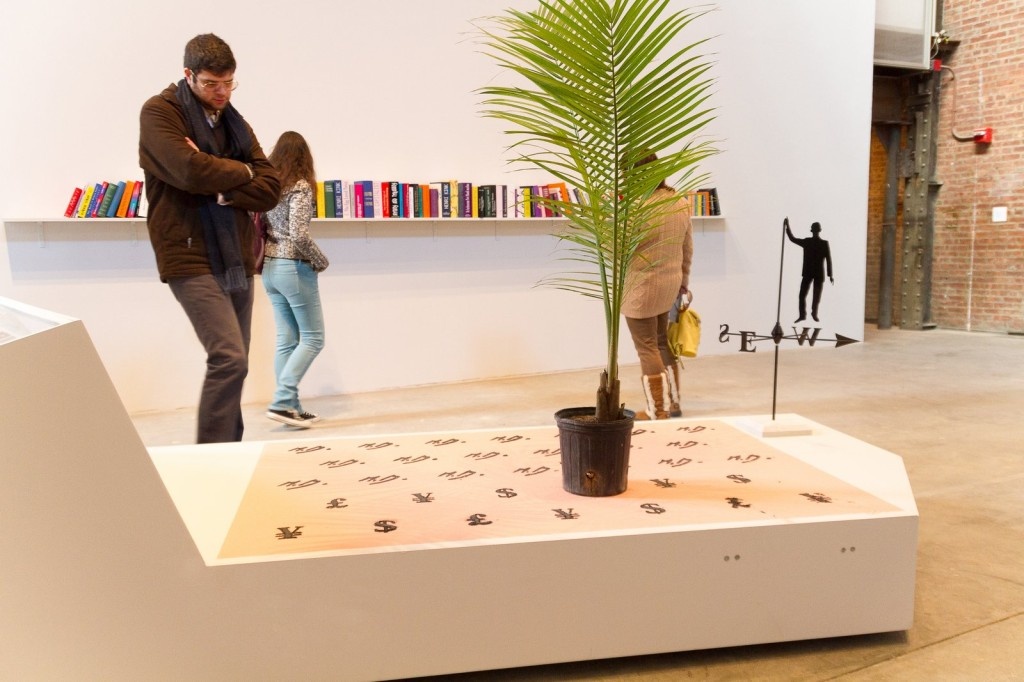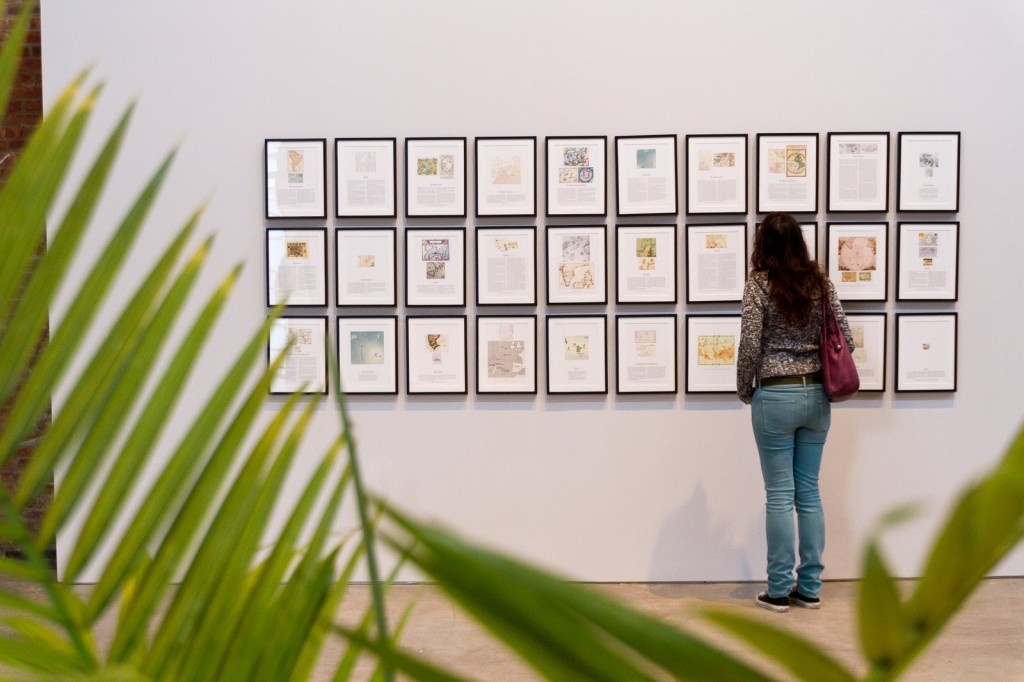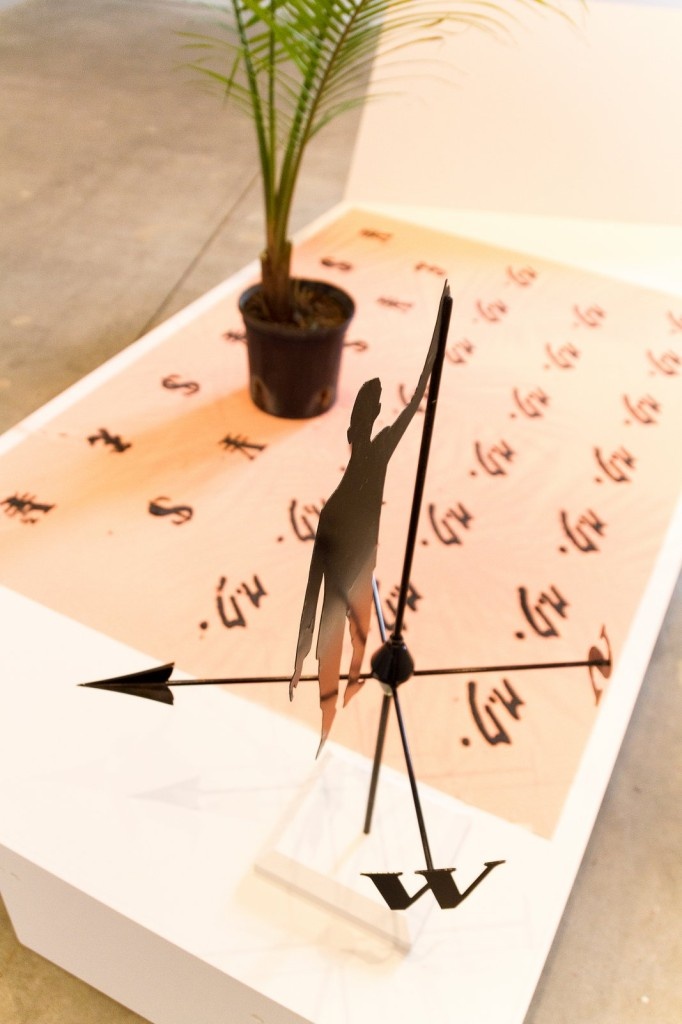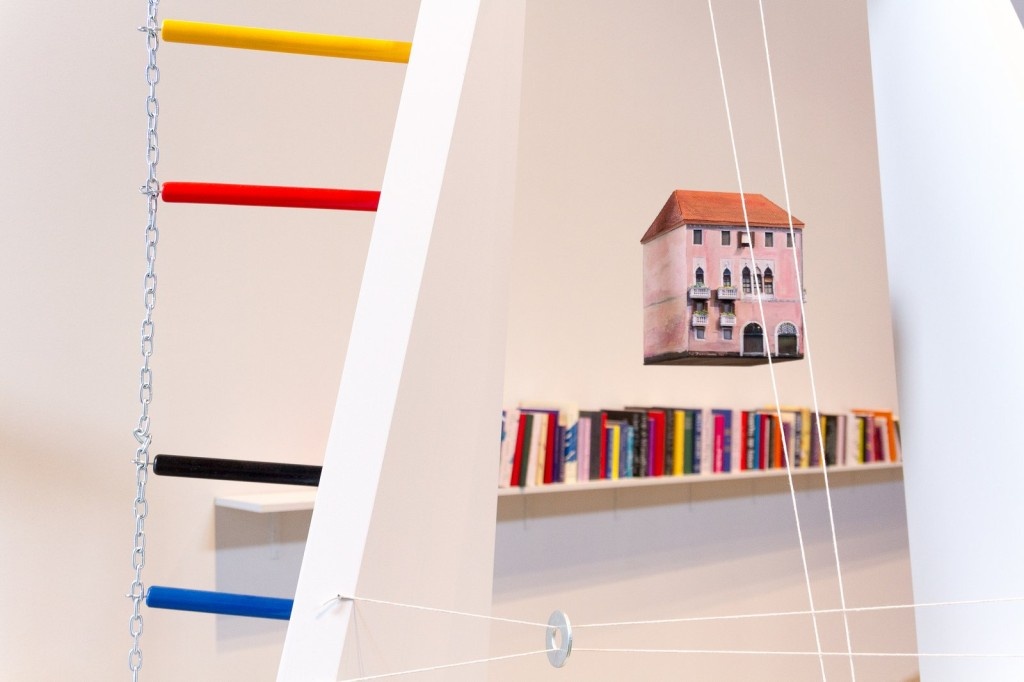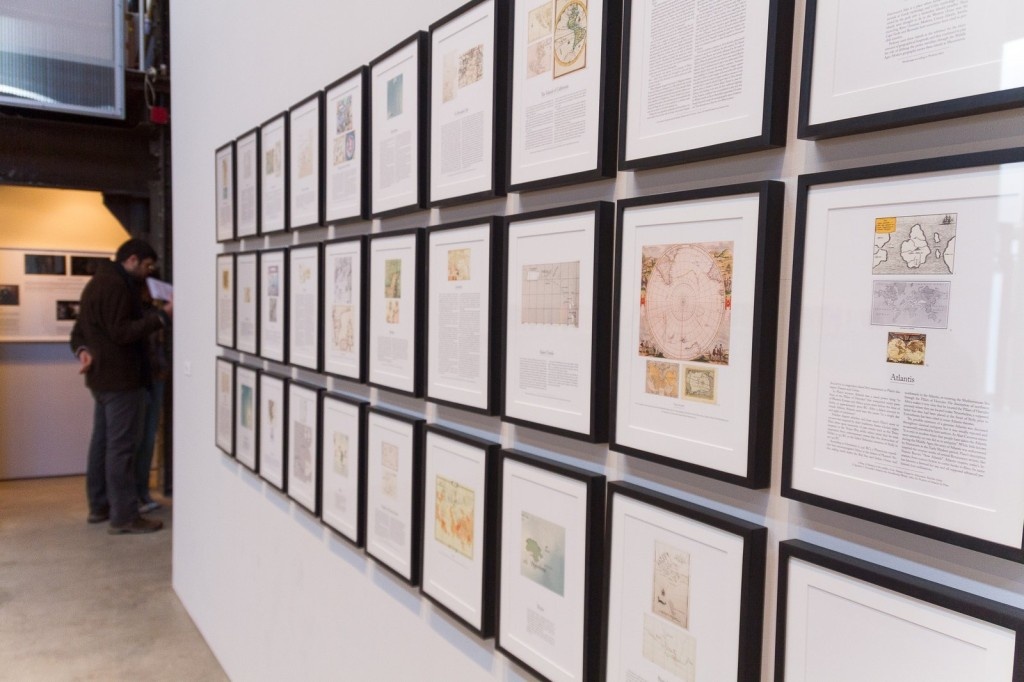In November, Contemporary Lynx visited an exhibition by Agnieszka Kurant entitled Exformation. It was on at SculptureCentre in New York until end of January. The show is a worthy continuation of Kurant’s impressive ouevre. A clear narrative and thought-provoking outcome of her practice meant Contemporary Lynx chose it as one of the highlights in Polish art in 2013.
In December, Mary Ceruti – Chief curator of SculptureCentre – produced another installment for our ongoing project PostcART. She selected a still from Kurant’s new film Cutaways, developed by the artists in collaboration with the renowned film editor Walter Murch (Apocalypse Now, The Godfather, The Conversation). Cutaways is based on characters that were originally scripted and shot for various films but were subsequently edited out of the final versions of these films. Kurant wrote a script and involved the three original actors who were once cut out from Vanishing Point, The Conversation, and Pulp Fiction in her film – a meeting of these phantom characters. The narrative is based on surplus content and labour.
Kurant’s Exformation was also chosen by Martin Herbert from Art Review Magazine as a show one shouldn’t miss.
Contemporary Lynx caught Agnieszka to ask about Exformation, editing and curating and her future plans.
Contemporary Lynx: What does the title of your exhibition mean, and what does it refer to?
Agnieszka Kurant: “Exformation” is a term which was originally coined to refer to explicitly discarded information—immaterial data that are crucial in shaping contemporary narratives but disappear in the process of compression, editing or dispersion of memes. The unknown unknowns of knowledge. I wanted to bring up the notion of negative information, because the field of information is constituted by what is excluded from it, by deliberately discarded information. History is dependent on its cutouts. Complexity science has coined a term for this: “silent heroes.” A silent hero is someone who is integral to e.g. the discovery of some great thing but is never credited. The machine of the art world is contingent on the millions that never made it—writers with unpublished novels, failed artists with unseen work etc. These are the people who are buying magazines, museum memberships, attending screenings and openings. They are essential for the industry to exist. In “Exformation” I am interested in how phantoms, fictions, and magic play into economics. Exformation consists of phantoms that often haunt reality. I’m interested in the return of the exformative “real”. The project Cutaways is a certain culmination of my research around this subject. I got interested in phantom characters—the invisible universe of characters that have been completely deleted from the final cut of feature films, leaving no apparent trace in the stories yet strangely belonging to them—a sort of no man’s land, populated by these characters and their deleted narratives. I wanted to address editing as basic common intellectual and political tool present everywhere in our lives.
CL: You developed Cutaways in collaboration with the renowned film editor Walter Murch. Editor’s role resembles that of a curator’s. They both decide about the final version of the film or exhibition. In both cases, they select or excise particular elements. What did your collaboration with the editor look like and who had the last word?
AK: I invited Walter Murch when the idea behind the film was already shaped. I asked him whether he had ever cut out a character or narrative from movies that he worked on. He indicated McNaught, a character (the best friend of Harry Caul) that he edited out from Coppola’s The Conversation. Then he put me in touch with Coppola and Zoetrope, and many other producers and directors. I continued the research myself and managed to collect nearly 200 cutout characters. The final movie encompasses footage of three characters edited out from three major American films. These characters were played (then and again, now, in my film) by Charlotte Rampling (discarded from Vanishing Point), Abe Vigoda (removed from Coppola’s The Conversation) and Dick Miller (cut out from Tarrantino’s Pulp Fiction). The editing was supervised by Murch and his collaborator Tim Sternberg.

Agnieszka Kurant, Cutaways, Film Still, SculptureCenter, New York, 2013, courtesy of SculptureCenter
CL: Or, maybe your artistic activity is to prove that nowadays it is impossible to explicitly define who an artist, editor or curator is. Our roles overlap and mix, the differences are becoming more and more blurred.
AK: I have always been interested in curating understood as working with a complex form or medium —curating as an art form. Editing is a proto-curating. Similarly to editing, curating is also (among other things) about deciding what is in and what is out. Each artist edits his/her works too. To some extent, each artist must make curatorial decisions, e.g., which works to choose for an exhibition, how to link and juxtapose them, how to place/locate them in a gallery or museum space. These issues are often the subject of a dialogue between the artist and the curator; as in the case of films, the most important decisions, determining the final shape of a film, result from discussions between the director and the editor. Interestingly, the editors remain half-anonymous. Most moviegoers cannot name more than one famous editor, sometimes none, which leads us to think of editing as the invisible art. Many filmmakers believe that the best editing is that which viewers are not aware of and do not notice. Of course, there are also more expressive schools of editing. Generally, however, editors are “invisible” while the role of curators in recent times has grown enormously. Walter Murch treats editing exactly as I treat curating—he perceives it as an art form. The subject of our conversations was, among others, mutual interest in creating a script for editing a movie and for an exhibition. Murch has been creating some kind of visual editing scripts for years and I have been considering the idea of creating an exhibition script making a reference to conceptual scores by British composer Cornelius Cardew for a long time, too.
CL: Cutaways apart from being an element of your Sculpture Center exhibition was also one of the commissions of Performa13 biennial. Other Polish artists showcased at Performa, such as Konrad Smolenski, Radek Szlaga and Katarzyna Krakowiak utilized the theme of the use of apparently useless fragments— wastes. You are also interested in the elements rejected during the manufacturing process e.g. in Cutaways. Do you see it as a broader trend of upcycling adequate in the world flooded by products?
AK: The use of leftovers and trash is the theme that art has explored for over hundred years, if not always. From Dadaism, Pop Art, Neo Dada, through Conceptual art, Appropriation art, to what Nicolas Bourriaud defined as the “post-production.” My interests are associated not so much with the waste and trash, as with the invisible and with what I call “phantom capital” – various forms and accumulations of surplus, redundant and potential material. I am more interested in the spaces/gaps after something cut out than in the garbage. I am looking for the potential and phantom capital in places where there is seemingly nothing: e.g. fragments of too long silent pauses excised from radio broadcasts of public speeches of politicians and intellectuals. I am interested in the “economy of invisibility.”
CL: You are interested in the phantom phenomena that although exist in the collective imagination, in reality are fiction (work Maps of Phantom Islands), or it is not certain whether they have ever been created (for example, works by artists in the Phantom Estate). Why this subject?
AK: For a number of years I have been interested in the paradoxical process consisting in the fact that the failed ideas of the alleged dematerialization of the art object proclaimed by Conceptual art (which in fact produced certificates of authorship and visual documentations replacing the “immaterial” works and becoming an even more fetishized objects of trade in the art market) have actually been realized by late capitalism. For example, seventy percent of money is phantom—it exists virtually, on computers—but still produces physical consequences. An important piece of “real estate” in contemporary cities such as NY are “air rights” – the air above buildings that becomes an object of trade allowing for creating “million dollar views” by shaping what is visible from a given property’s window. One of cognitive capitalism’s agents is what I call “phantom capital,” redundant and potential material that despite its immaterial status acts as proxy of economic value and political meaning and can have substantial effects on day-to-day life. The only economics capable of capturing the nature of contemporary capitalism is the same economics that theoreticians of culture refer to when they talk about specters, ghosts, and delusions: libidinous economics. Our entire political economy has shifted toward immaterial labor, a model no longer based on physical work in a factory but on the production of knowledge and conceptual products like copyrights, patents, and ideas. In my recent works I’m exploring that phenomena and processes and how they can be seen through the legacy of conceptual art.
I am interested in the extinction of singular authorship looming over our epoch. Knowledge and labor are increasingly produced by a self-organized complex system of collective intelligence based on millions of micro-contributions. Artistic creativity and value production in art undergo a mystification. They operate via one of the major common myths surrounding art: the idea of creativity as an individual process. In my work I am trying to draw attention to creativity as a product of collective intelligence and complex, nonlinear processes.
I am interested in the hybrid status, aura, value, and authorship of objects. Much of my practice takes up objects and places capable of transformation and inversion—works which can always be unmade or are reversible. Works which appear or disappear. It is interesting, for example, to watch a meme circulate, change, and grow exponentially. I think of artworks as living organisms with their own agency and agenda.
CL: Research that you do for the projects is tedious work, reminiscent of the work done by an archivist. You never know whether it will end up in success or failure. What is the research process for you in the context of your artistic creativity?
AK: Research is an extremely important element of my work. Most often, I collaborate with many different people that help me. In the case of Cutaways, it was Walter Murch, Peter Becker from Criterion Collection, Tom Luddy from Telluride Festival, and many other producers and directors. In the case of Phantom Estate, it was the large group of people I interviewed, i.e. Maria Glissen, Anie Dedeker, Anka Ptaszkowska— numerous partners, curators and collaborators of the artists that I researched. Usually I have good intuition in terms of where to “dig” in search of something interesting that might prove essential for my work. But of course there is no guarantee. When working on the Phantom Estate I happened to turn into many blind alleys, and only a small part of my research was used for creating the project. On the other hand, however, I met a lot of fantastic artists, academics and art lovers so time is never lost.
CL: Exformation exhibition has been on show at Stroom den Haag in the Netherlands since December. What are your other artistic plans for 2014?
AK: At the moment, I am working on a solo project for the Guggenheim Museum in New York City (2014/2015). In September 2014 I am having a solo exhibition at Tanya Bonakdar Gallery, NYC. In June, at the Palais de Tokyo in Paris, I am showing the project that I prepared (together with Aleksandra Wasilkowska) for Venice Bienniale in 2010. In the second half of the year, I will also have my solo exhibition at Botkyrka Konsthall in Stockholm.
CL: We wish you good luck
Thank you
SculptureCenter is New-York based not-for-profit arts institution founded by artists in 1928, dedicated to experimental and innovative developments in contemporary sculpture. SculptureCenter commissions new work and presents exhibits by emerging and established, national and international artists.
Stroom Den Haag (an independent foundation founded in 1989) is a centre for art and architecture with a wide range of activities based in Haag. Starting from the visual arts, architecture, urban planning and design the program focuses on the urban environment.
Translated by Urszula Ploch-Syhlowej
Edited by Agnieszka Kurant




